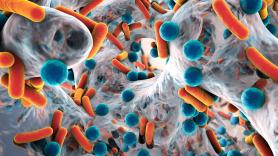1. The resistance problem
Antibiotics resistance causes an estimated 700,000 deaths each year. If this continues, the number will reach ten million annual deaths by 2050. These were the figures published in 2014 by a committee of experts led by Lord Jim O’Neill under the umbrella of the British government.
“We need a global plan to tackle this situation,” warned Jordi Vila, head of the Microbiology Department at Hospital Clinic Barcelona, director of the Antimicrobial Resistance Initiative at ISGlobal and co-leader of this B·Debate session. The main mechanism behind resistance is selective pressure. The genomes of bacteria are always changing randomly and some of these changes can give them advantages in fighting a certain type of antibiotics. When that type is used, and especially if not administered correctly, the most resistant bacteria tend to survive (be selected) and will later have an easier time spreading.
“There are different ecological niches we have to take into account when using antibiotics,” explained Vila, referring to veterinary uses, both in animals and the food chain; and use in developing countries, in the community and in hospitals. “It is a complicated situation with many interactions among these niches and they can be spread through food, migratory birds, international travel, etc.”
This global problem also has significant economic consequences. If nothing is done to stop the situation, according to the 2014 report, the impact on countries’ gross national product could be between 2% and 3.5%. This is the same as the estimated impact of the ominous two-degree increase in temperatures due to global warming.
For Laurence Roope, a researcher at the University of Oxford Health Economics Research Centre, there is a clear similarity between antibiotics resistance and climate change or the climate crisis. Both in their characteristics and consequences, and in the challenge they pose in terms of informing the public and raising awareness. In both cases there is a ‘tragedy of the commons’, in which individuals, acting rationally, end up destroying a limited shared resource. Plus, according to Roope, “indiscriminate use of antibiotics, like carbon, has future costs. There isn’t much incentive for people to change their behavior now because the consequences are much further down the line and are inevitable unless other people also reduce their consumption; and the models are complex and, to a certain extent, uncertain.” However, “given the possible consequences, and just as preventive measures are the right move for climate change, they should also be applied in the case of resistance.”
Roope posits that the economic consequences could help bolster the message, both to reduce consumption of antibiotics and incentivize the development of new molecules. But this field is problematic for companies, because they are “a product that is difficult to develop and should be used as little as possible,” which is why he proposes that “profit should not be tied to volume sold, as antibiotics have value as a treatment option, beyond how often they are actually used.” He also reminded the audience that, right now in the world, more people still die because they don’t have access to antibiotics than due to antibiotic resistance.
Apart from researching new antibiotics, some strategies could come through repositioning old molecules, as noted Jesús Rodríguez-Baño, president of the European Society of Clinical Microbiology and Infectious Diseases (ESCMID). “Some aspects of old drugs weren’t studied in depth enough, and could also be used for different types of infections,” he noted. Or they could come from a combination of drugs, as explained Javier Garau, head of internal medicine at Clínica Rotger Quironsalud in Palma de Mallorca. However, “sometimes this concept is abused, out of fear of not covering everything. We need more studies on the most promising combinations.”
However, as Jordi Vila noted, “no matter how many measures we implement, we’ll never get to zero resistance. We’re going to need new antibiotics.” Luis Martínez-Martínez, head of the Microbiology Service at Hospital Universitario Reina Sofía in Córdoba, warned that there are fewer and fewer new molecules being discovered, and even for them resistances are appearing. Plus, “only one in five antibiotics that start phase I clinical trials are ever approved.”
Ursula Theuretzbacher, founder of the Center for Anti-Infective Agents in Vienna, Austria, gave her analysis of current research into new antibiotics. The cons: the vast majority of those being tested in the clinical phase are variations of old ones, so they are susceptible to cross resistance (the same mechanism causes resistance to several similar antibiotics). The pros: more than half of the pre-clinical studies involve a less traditional approach. And “we need new targets, new mechanisms of action.”



